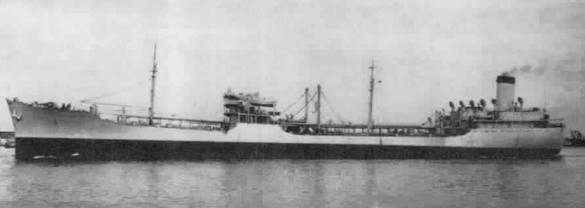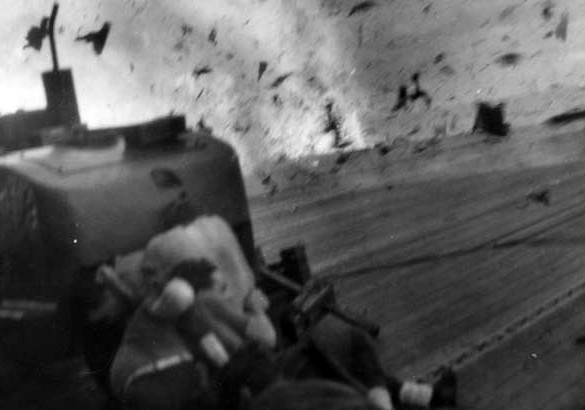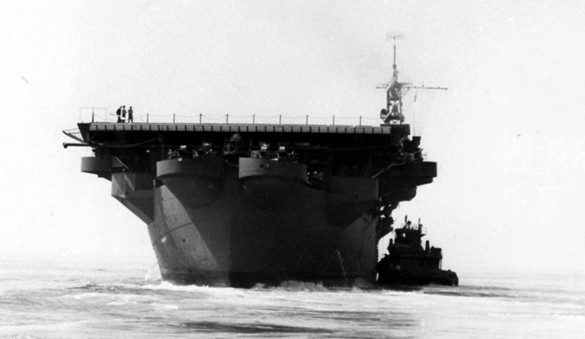August 09, 2009
The Bogue-class was a relatively unsophisticated design, essentially slapping a flight deck on top of the hull, and changing the old main deck to a hangar. While effective, more hulls were desperately needed to escort convoys in the Atlantic and support operations in the Pacific. To overcome the shortfall, the powers-that-be tagged four T-3 tanker hulls for conversion.

The resulting Sangamon-class was considered the best of the converted Jeep carrier classes.

Unlike every other escort carrier class, the four Sangamons were able to embark any carrier plane in the Navy arsenal, save for the Helldiver and the Corsair. The usual air complement was between 12-18 Wildcats and around the same number of TBF Avengers, though the Sangamon and the Santee occasionally carried the Dauntless dive-bomber. The Suwannee and the Chenango never did, for one reason or another.
They displaced 24100 tons (full load), as opposed to 16600 tons for the Bogues. Unsurprisingly considering their tanker origins, they carried nearly three times as much fuel as well, giving them a range of 24000 nautical miles @ 15kts (the Bogues range was just over 10000nm). They also had a huge bunkerage for airplane fuel. As a matter of fact, they could carry more fuel than a Yorktown or Lexington-class fleet carrier, and only a bit less than the Essex-class, despite being about 350 feet shorter. In effect, the Sangamon-class were self-escorting tankers.
All four began their service life in late 1942, covering the North Africa landings of Operation Torch. Immediately following, they transferred to the Pacific. Three of the four were hit by kamikaze (the Chenango avoided that fate, but suffered severe damage when a F6F crash-landed on her deck and smashed into planes parked forward). The class as a whole suffered three kamikaze hits, four bomb strikes, and a submarine torpedo hit, yet all four survived... again, testament to the survivability of their larger-sized tanker origins.

The only thing that separated them from CVL status was their speed. 18kts maximum was pretty good for a transport, and excellent for an escort carrier, but much too slow to operate with the battle fleet, where 25-30kts was considered standard. That's about the only statistic that the Sangamons were inferior to the Independence-class CVL.
All four ships of the class survived the war, earning 41 battle stars between them. The Chenango and Santee continued in US Navy service as CVHEs (Carrier, Helicopter, Escort) until the late '50s. The Suwannee was put into the mothball fleet. The Sangamon, amusingly, was returned to commercial service in her original tanker configuration after the war, until she was scrapped in 1960.

Posted by: Wonderduck at
02:11 PM
| Comments (9)
| Add Comment
Post contains 660 words, total size 7 kb.
Posted by: toad at August 10, 2009 12:57 AM (Pe1td)
Posted by: Steven Den Beste at August 10, 2009 10:21 AM (+rSRq)
I saw the Bowfin's battle flag at the memorial in Hawaii, and noticed that it had a bus on it. If they figured out how to torpedo a bus, you can't really be safe on a ship...
Posted by: Avatar_exADV at August 10, 2009 04:18 PM (pWQz4)
Posted by: toad at August 12, 2009 06:20 AM (c6lyc)
There was a case where a sub sent a party ashore in rubber boats at night in Japan, and set an explosive charge on a railroad track and blew up a train. The train ended up on their battle flag.
But they didn't do it with a torpedo.
Posted by: Steven Den Beste at August 12, 2009 12:07 PM (+rSRq)
Posted by: Pete Zaitcev at August 12, 2009 01:03 PM (/ppBw)
It's certainly true that torpedoes have been used for things other than sinking ships.
They were the preferred weapon for destroying dams, for instance. Or would have been except that everyone defended against them with torpedo nets.
But I don't think I've heard of a case where someone deliberately tried to hit something well above water line by shooping a torpedo up to shore and trying to make it jump above water line. They just weren't that kind of projectile, not to mention being too damned expensive for that kind of crap.
If a sub saw a train ashore, it would be more likely to fire on it with the deck gun. I think that story is apocryphal, likely caused by someone seeing the battle flag I talked about and making up their own story about how it happened.
Posted by: Steven Den Beste at August 12, 2009 07:57 PM (+rSRq)
Posted by: Steven Den Beste at August 12, 2009 07:57 PM (+rSRq)
Posted by: Avatar at August 12, 2009 11:43 PM (vGfoR)
46 queries taking 0.1384 seconds, 170 records returned.
Powered by Minx 1.1.6c-pink.









